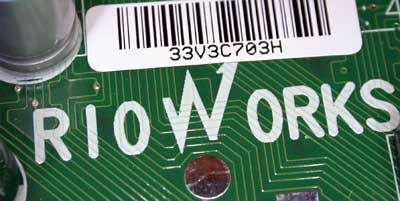AMD Opteron Coverage - Part 3: The First Servers Arrive
by Anand Lal Shimpi on April 23, 2003 9:41 PM EST- Posted in
- IT Computing
Chances are you've never heard of Rioworks the motherboard maker, and we wouldn't blame you. Not only is Rioworks a very widely known manufacturer, this is also their first try at an AMD based platform - luckily the Opteron is a brand new architecture so any lessons learned with the Athlon MP wouldn't have done Rioworks much good. We have actually reviewed a couple of Rioworks motherboards during the days of the massive Slot-2 Pentium II Xeon processors and never really had any bad experiences with them, but with all of the options out there, why did Appro choose Rioworks?

Considering Tyan was everyone's best friend during the Athlon MP days, we found it peculiar that Appro didn't use Tyan's solution in their 1100H. It turns out that no one was using Tyan's design simply because of availability; citing that Opterons won't be available in large quantities until June, Tyan's board won't be available in quantity until then either. It remains to be seen whether Tyan's estimates are correct or not; the Opteron 244 will not be available in quantity until June however the rest of the line should be available immediately.
So we know why Tyan is out, but what about MSI? The biggest problem with MSI's board design is the unique (read: strange) setup of memory slots. Remember that each Opteron CPU has its own memory controller, and thus for every CPU you have to have a dedicated set of memory slots on the motherboard.
Most motherboard manufacturers have gone with either two DIMM slots per CPU (the bare minimum, remember the Opteron has a 144-bit wide memory bus that requires 72-bit ECC DIMMs to be installed in pairs) or four DIMM slots per CPU. MSI however has outfitted their board with 4 slots for CPU0, but only 2 slots for CPU1. Although this type of a configuration can work, it makes very little sense, which is why a good deal of server manufacturers (e.g. Appro & Einux) have stayed away from MSI's design.
This leaves us with Rioworks; interestingly enough, the motherboard design is quite good, which just reinforces the fact that being popular doesn't necessarily mean you'll have well thought-out designs.
The board features 4 PCI-X slots and two regular 32-bit PCI slots, but in the 1100H all but one of these slots goes to waste. Although Appro didn't bundle a riser card with our 1100H (a huge oversight on their part, customers will definitely demand one be included), a riser card will allow you to use the last PCI-X slot. Given that the motherboard features dual Broadcom Gigabit Ethernet controllers and an integrated Serial ATA controller, the only need for expansion would be a SCSI RAID card.

Beneath this heatsink is the on-board 4-port SATA controller

...that drives these four ports
When talking about expansion on the 1100H you have to keep in mind that your options are extremely limited. With no removable drive bays, adding new hard drives and even moving to SCSI isn't as simple of a task as it should be. Although the two thumbscrews make it easy for you to gain access to the motherboard, the 1100H isn't really designed to be upgraded with ease outside of installing faster CPUs or more memory. We'll get to why in a minute.










0 Comments
View All Comments